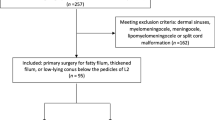Abstract
Introduction
Intradural transection of the filum terminale (FTI) is often used to treat tethered cord syndrome. Recently, some have proposed that the extradural part of the filum terminale (FTE) can be sectioned with equal results but with fewer complications. Therefore, the present cadaveric study aimed to evaluate the anatomical foundation of such procedures.
Methods
A posterior lumbosacral approach was performed on five fresh-frozen cadaveric specimens to expose both the FTI and FTE. Tension was then applied to the FTE and observations and measurements made of any movement of the FTI. Other morphological measurements (e.g., length, diameter) of the FTI and FTE were also made.
Results
Although very minimal movement of the FTI was seen in the majority of specimens following tension on the FTE, no specimen was found to have more cranial movement of the conus medullaris or cauda equina. The mean length and diameter of the FTI was 52.2 and 0.38 mm, respectively. The mean length and diameter of the FTE was 77 and 0.60 mm, respectively. The force necessary to move the FTI with tension applied to the FTE had a mean of 0.03 N. The average distance that the FTI moved with distal FTE tension was 1.33 mm. All specimens had a thecal sac that terminated at the S2 vertebral level. And no specimen had a low-lying conus medullaris, cutaneous stigmata of occult spinal dysraphism, or grossly visible adipose tissue in either the FTI or FTE.
Conclusions
Based on our studies, tension placed on the FTE has very little effect on the FTI and no obvious effect on the conus medullaris or cauda equina. Therefore, isolated transection of the FTE for a patient with tethered cord syndrome is unlikely to have significant effect. To our knowledge, this is the first study to quantitate the distal forces needed on the FTE to move the FTI.


Similar content being viewed by others
References
Arya NG, Weissbart SJ (2017) Central control of micturition in women: brain-bladder pathways in continence and urgency urinary incontinence. Clin Anat 30:373–384
De Vloo P, Monea AG, Sciot R et al (2016) The filum terminale: a cadaver atudy of anatomy, histology, and elastic properties. World Neurosurg 90:565–573
Garceau GJ (1953) The filum terminale syndrome (the cord-traction syndrome). J Bone Joint Surg Am 35–A:711–6
Griessenauer CJ, Raborn J, Foreman P, Shoja MM, Loukas M, Tubbs RS (2015) Venous drainage of the spine and spinal cord: a comprehensive review of its history, embryology, anatomy, physiology, and pathology. Clin Anat 28:75–87
Hayashi T, Kimiwada T, Kohama M et al (2018) Minimally invasive surgical approach to filum lipoma. Neurol Med Chir (Tokyo) 58:132–137
Hendrix P, Griessenauer CJ, Cohen-Adad J, Rajasekaran S, Cauley KA, Shoja MM, Pezeshk P, Tubbs RS (2015) Spinal diffusion tensor imaging: a comprehensive review with emphasis on spinal cord anatomy and clinical applications. Clin Anat 28:88–95
Hertzler DA, DePowell JJ, Stevenson CB, Mangano FT (2010) Tethered cord syndrome: a review of the literature from embryology to adult presentation. Neurosurg Focus 29:E1
Maddali P, Moisi M, Page J, Chamiraju P, Fisahn C, Oskouian R, Tubbs RS (2017) Anatomical complications of epidural anesthesia: a comprehensive review. Clin Anat 30:342–346
Mortazavi MM, Harmon OA, Adeeb N, Deep A, Tubbs RS (2015) Treatment of spinal cord injury: a review of engineering using neural and mesenchymal stem cells. Clin Anat 28:37–44
Mortazavi MM, Verma K, Harmon OA, Griessenauer CJ, Adeeb N, Theodore N, Tubbs RS (2015) The microanatomy of spinal cord injury: a review. Clin Anat 28:27–36
Mourgela S, Anagnostopoulou S, Sakellaropoulos A, Koulousakis A, Warnke JP (2008) Sectioning of filum terminale externum using a rigid endoscope through the sacral hiatus. Cadaver study. J Neurosurg Sci 52:71–74
Prats-Galino A, Reina MA, Mavar Haramija M, Puigdellivol-Sánchez A, Juanes Méndez JA, De Andrés JA (2015) 3D interactive model of lumbar spinal structures of anesthetic interest. Clin Anat 28:205–212
Puigdellívol-Sánchez A, Reina MA, Sala-Blanch X, Pomés-Talló J, Prats-Galino A (2016) Pythagoras and cosines: the skin-dural sac distance and optimal angles in paramedian spinal anesthesia. Clin Anat 29:1046–1052
Rojas S, Ortega M, Rodríguez-Baeza A (2018) Vascular configurations of anastomotic basket of conus medullaris in human spinal cord. Clin Anat 31:441–448
Royo-Salvador MB, Solé-Llenas J, Doménech JM, Gonzàlez-Adrio R (2005) Results of the section of the filum terminale in 20 patients with syringomyelia, scoliosis and Chiari malformation. Acta Neurochir 147:515–523
Saker E, Henry BM, Tomaszewski KA, Loukas M, Iwanaga J, Oskouian RJ, Tubbs RS (2017) The filum terminale internum and externum: a comprehensive review. J Clin Neurosci 40:6–13
Shah AP, Mevcha A, Wilby D, Alatsatianos A, Hardman JC, Jacques S, Wilton JC (2014) Continence and micturition: an anatomical basis. Clin Anat 27:1275–1283
Tarlov IM (1938) Structure of the filum terminale. Arch Neurol Psych 40:1–17
Tubbs RS, Murphy RL, Kelly DR, Lott R, Salter EG, Oakes WJ (2005) The filum terminale externum. J Neurosurg Spine 3:149–152
Tubbs RS, Malefant J, Loukas M, Jerry Oakes W, Oskouian RJ, Fries FN (2016) Enigmatic human tails: a review of their history, embryology, classification, and clinical manifestations. Clin Anat 29:430–438
Van Schoor AN, Bosman MC, Bosenberg AT (2015) Descriptive study of the differences in the level of the conus medullaris in four different age groups. Clin Anat 28:638–644
Veronesi V, Sacco C, Mastronicola C, Staffa G (2017) Transhiatal approach to filum terminale externum sectioning in adult patient with tethered cord syndrome: case report. Oper Neurosurg
Yamada S (2004) Tethered cord syndrome in adults and children. Neurol Res 26:717–718
Author information
Authors and Affiliations
Corresponding author
Ethics declarations
Conflict of interest
The authors have no conflicts of interest to report.
Rights and permissions
About this article
Cite this article
Patel, M., Vetter, M., Simonds, E. et al. Mechanical relationship of filum terminale externum and filum terminale internum: is it possible to detether the spinal cord extradurally?. Childs Nerv Syst 34, 1767–1770 (2018). https://doi.org/10.1007/s00381-018-3837-3
Received:
Accepted:
Published:
Issue Date:
DOI: https://doi.org/10.1007/s00381-018-3837-3




